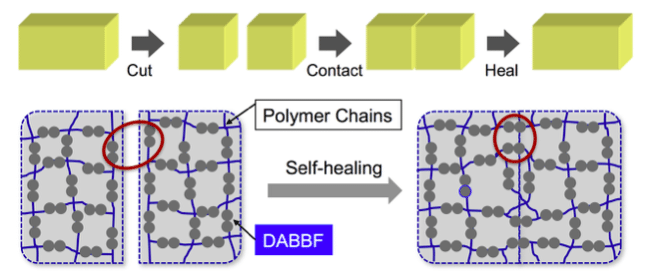
Carbon-carbon single bonds are one of the most important bonds in natural/artificial organic molecules and materials. Generally, they are regarded as being strong, irreversible, and static covalent bonds. However, chemical modification around the C–C bonds including the introduction of steric hindrance, electronic effects, and resonance stabilization can drastically lower their dissociation energies.
One extreme example is the central C–C bond in diarylbibenzofuranone (DABBF, Figure 1), which is known to reversibly cleave and reform under mild conditions. Recently, Professor Hideyuki Otsuka from Department of Chemical Science and Engineering, Tokyo Institute of Technology, Japan and his co-workers reported a series of works on the design and synthesis of functional polymers with DABBF. Previously, the antioxidant properties of DABBF have been the focus of attention rather than its dynamic nature, but recently, DABBF has been recognized as a dynamic covalent bonding unit and utilized in the field of polymer science.

Figure 1. Chemical structure and equilibrium of diarylbibenzofuranone (DABBF) with the corresponding arylbenzofuranone blue radicals. Credit: Hideyuki Otsuka
The functions of DABBF-containing polymers can be divided into two categories. One is the self-healing property of DABBF-containing cross-linked polymers originated from the exchangeability of central C–C bonds in DABBF. The central C–C bonds in DABBF can undergo selective, reversible cleavage and reformation with no irreversible side reactions under equilibrium conditions even at room temperature in air. Self-healing of DABBF-containing polymers such as cross-linked polymer gels, bulk network polymers, and polymer/nanocellulose composites was successfully demonstrated under mild conditions. Mechanical properties and surface morphologies of the DABBF-containing polymer samples were almost recovered after the self-healing experiments.

Figure 2. Schematic representation of self-healing behavior in DABBF-containing cross-linked polymers. Credit: Hideyuki Otsuka
The other function is the mechanochromic property of DABBF-containing polymers. The generated carbon-centered radicals from DABBF molecules exhibit blue color, which promises stimuli-responsive color changes of polymeric materials. Actually, mechanochromism of DABBF-containing polymers such as linear polymers, star polymers, cross-linked polymers, polymer gels, and polymer/inorganic composites was observed in response to various types of mechanical stimulation.
The incorporation of DABBF linkages into polymer structures significantly affects their macroscopic behaviors, enabling fascinating functions in response to mild stimulation. Self-healing and stress detection are representative properties of DABBF-containing polymers. The former involves highly mobile DABBF units, whereas the latter requires that the molecular mobility and the recombination of activated radicals be suppressed.
These findings are described in the article entitled Reorganizable and stimuli-responsive polymers based on dynamic carbon-carbon linkages in diarylbibenzofuranones, recently published in the journal Polymer. This work was conducted by Keiichi Imato from Waseda University and Hideyuki Otsuka from the Tokyo Institute of Technology.








